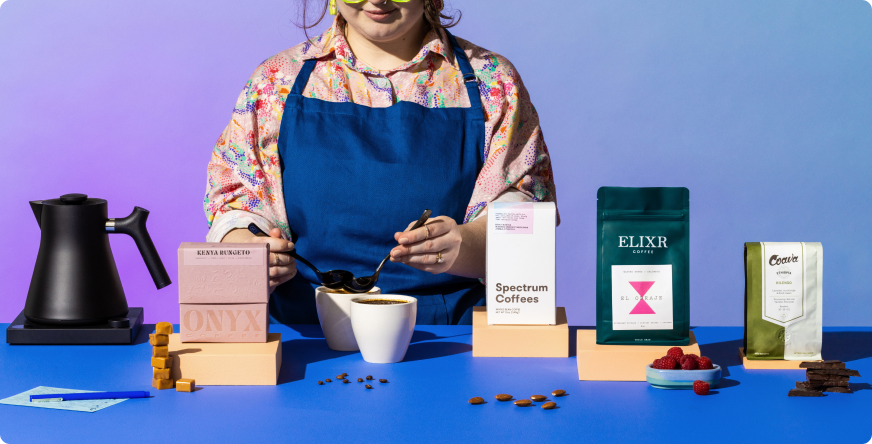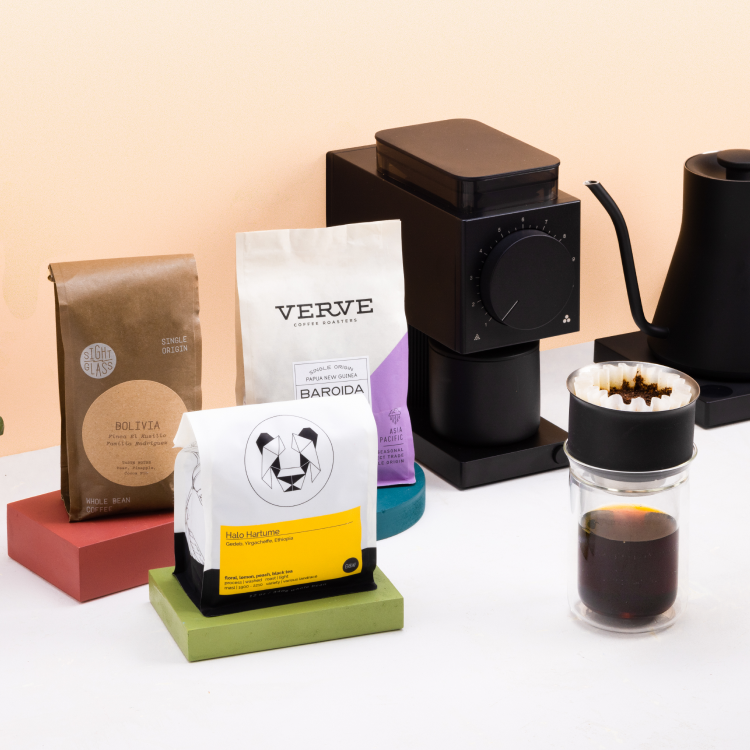If you're beginning to explore the vast world of coffee there’s a lot to learn and even more to taste. But if you feel overwhelmed when you’re perusing the coffee aisle at the grocery store or reading a coffee shop menu, it might keep you from exploring all that coffee has to offer.
By immersing yourself in coffee lingo you can better understand brew types, flavor profiles, and the characteristics of different types of brew/brew methods.
We’ve put together a handy guide that helps you navigate the world of coffee lingo. With this boiled-down information, you’ll be a coffee expert in no time.
Coffee Drink Lingo:
The first thing you need to understand when it comes to coffee lingo is the different types of coffee available. While you may be familiar with standard drip coffee, there are a variety of options available, each of which offer a unique flavor profile.

-
Cold Brew: Cold brew coffee is immersed in filtered water at cool temperatures for a long period of time. This process can take around 16-24 hours and produces a full-bodied flavorful cup of coffee with lower perceived acidity. Cold brew coffee can be enjoyed on its own or with various types of milk and is usually served with ice cubes to maximize that refreshing taste.
-
Pour-Over: A pour-over coffee is a coffee made by pouring water over ground coffee in a device called a dripper. Pour-over coffee generally takes 3-4 minutes to brew, and is characterized by a complex body of flavor made possible by slow, decisive pouring of water over coffee grounds.
-
Drip coffee: A method of brewing coffee by pouring water over a bed of grinds and a filter. This is solely through gravity, and no other external pressure is applied as water runs through your grinds. There’s a few ways to make drip coffee. You can try a pour-over method, an automatic drip coffee maker, a slow drip cold brewer etc. Often times folks use drip coffee as a synonym for the pour-over process. Drip coffee can mean pour-over but pour-over doesn’t necessarily mean drip coffee. Kind of like a square can be a rectangle but a rectangle can’t be a square – you feel me?
-
Latte: A latte is smooth, creamy coffee that is delicate in flavor. A latte is typically 11-12oz, comprised of 2 shots of espresso and milk steamed smooth and thin.
-
Cappuccino: Cappuccinos are somewhat similar to lattes but have a different coffee-milk-foam ratio. While lattes have thinner foam and typically come in a larger 11-12oz cup, cappuccinos are typically offered in smaller 6-8 oz cups with the same 2 shots of espresso and generally have thicker milk/foam, giving cappuccinos a distinct flavor that tends to be a bit stronger in coffee flavor than lattes.
-
Espresso: Espresso is a type of concentrated coffee brewed at high pressure. Different from traditional coffee, espresso is thick and creamy. As noted above, espresso is a key ingredient in lattes and cappuccinos as well as other “espresso-based drinks”. It can also be enjoyed on its own.
-
Macchiato: This espresso-based drink only contains a small amount of milk. In Italian, macchiato means "marked or stained" and with just a dash of milk, traditionally cool-steamed milk foam, this ‘marked coffee’ is perfectly named.
Coffee Brewing Lingo

-
Agitation: Agitation is a term used to describe the disturbance of coffee grounds during brewing. But don’t worry, this mild disturbance helps to pull flavor from coffee grounds.
-
Bloom: The Bloom is a term used to describe the releasing of gases on the initial pour of water during the coffee brewing process. The Bloom often takes 30-40 seconds, and is the process in which gases in the grounds activate and release with the addition of water. Allowing your coffee to “bloom” makes for a more complex cup with more developed flavors present.
-
Grind Size: Coffee grind sizes include various types such as fine, medium and coarse. You’ll even see grind sizes described as combinations of those three, such as medium-fine or medium-coarse. Depending on the type of brew method and secondarily what type of coffee you’re interested in, you’ll need a recommended grind size to produce something that’s delicious.
-
Extraction: Extraction refers to the act of pulling flavor out of coffee grounds with water. Many factors can affect extraction, including but not necessarily limited to water temperature, grind size, water flow velocity / water pressure, and type of brewer / brewing method.
-
Over or Under Extracted: These terms refer to pulling too much or too little flavor from your coffee in the final cup. Over extracted coffee is often characterized by excessive bitterness, chalkiness, or an overly drying finish. Under extracted coffee is often perceived as weaker, watery, or excessively sour at the finish.
Ten Types of Coffee Gear You Need to Get Familiar With
Of course, there’s more to making the perfect cup of joe than simply understanding the different types of coffee. You’ll want to know as much as you can about the gear you’ll be using to make a satisfying cup. Here are some of the most common tools used to brew coffee.

-
French Press: A French press is a manual brewer that uses warm water, coffee grounds, and a French press to brew coffee. This produces a full-bodied and flavorful cup of coffee by plunging the coffee grounds, which are immersed in the main chamber of the French Press along with hot water, to the bottom after brewing.
-
Pour-over: Pour-over coffee is when hot water is poured over coffee grounds in a designated filter, which is also in a device called a “dripper”. There are two main types of dripper: a flat bottom dripper, like Stagg X, and a conical dripper. Flat bottom drippers typically have flat bottoms with 1 or more small exit holes, whereas conical drippers are cone-shaped and have 1 large exit hole.
-
Aeropress: This immersion-style coffee maker uses medium-fine ground coffee that is immersed in the chamber with a short brew time.
-
Siphon: This specialty coffee maker brews coffee through the use of two chambers where natural gravity and vapor pressure are used to brew a pure and flavorful cup of coffee.
-
Grinder: A coffee grinder is a device that grinds coffee beans so they can be brewed. There are two main types of grinders: Burr grinders and Blade grinders. Burr grinders are more preferable for coffee because they produce more consistent grounds. If your grounds are more consistent particle-wise, your brews will also be more consistent!
-
Burr: A burr is part of a coffee grinder that allows you to grind or crush coffee beans into a certain size.
-
Filter: A coffee filter is a filter that is used when brewing drip coffee. They are made out of metal, cloth, paper, and plastic, but are most often made out of paper (and we prefer these).
Blend vs Single Origin
The basis of good coffee starts with beans. The type of coffee beans you use and the grinding method you use will directly impact flavor. Here’s what you need to know:

- Single Origin: Single origin beans come from one origin (i.e. one farm or one coffee growing region). Single Origin coffees often offer high complexity and an excellent look at the terroir of their specific coffee growing region.
- Blend: Coffee blends involve various beans from different producers and countries. Blends usually result in a more intentionally balanced cup of coffee.
Flavor Profiles and Attributes

If you want to talk the talk in the coffee world, you will need a basic understanding of flavor profiles and how they affect the taste of your coffee.
-
Roast profile: A roast profile helps you understand the roast level of a coffee bean, most often described as “light”, “medium”, or “dark”.
-
Acidity: Acidity can add a perceived brightness, tartness, or sweetness to a coffee, much like the acidity in fruit. It can also vary wildly, like acidity in fruit can! Think of the difference in the mouth-puckering acidity of a Meyer lemon, which also has some sweetness, versus the slightly drying acidity of a green apple.
-
Fruity: This refers to a fruity quality in coffee, which denotes any number of fruity flavors in the coffee. This can range from stonefruit (peach, nectarine) to berry (blueberry, strawberry), from citrus to tropical fruit.
-
Sweet: This refers to an overall sweet and can be broken down into any number of very different-tasting subcategories, such as cane sugar or honey, molasses or caramel, and so on.
-
Nutty/Cocoa: Nuttiness can refer to the presence of any flavors of nut, from hazelnut and macadamia to peanut or almond. Cocoa can refer to any chocolatey flavors, generally that of a percentage of cocoa dark chocolate.
-
Floral: Floral attributes usually appear first in the fragrance (dry) and aroma (wet) of coffee, and then appear in the overall flavor of the coffee. These can range in flavor from a tealike floral profile (like an Earl Grey/English Breakfast tea, or chamomile / elderflower), to sweeter florals, like hibiscus or rose hips.
-
Earthy: Earthy flavors offer an aroma reminiscent of fresh earth, sweet earth, or wet soil. These attributes are generally marked as a detractort from the overall flavor of the coffee, although in certain cases in coffee grown in various parts of the world, these flavors can be considered favorable to the overall flavor of the coffee. Even a woodiness like ‘cedar’ can be considered favorable in a coffee if it contributes to the overall flavor in a favorable way, instead of overtaking it. Think about the earthiness of a turnip versus the earthiness of a sweet potato and how they can differ, or the spiciness of a wood like cedar versus the papery woodiness of a wood like plywood (you don’t have to have eaten these woods to know– you can basically know by aroma since taste is approximately 80% or more determined by smell!)
-
Bright: This can usually describe a coffee with clear and present acidity. Think of how a tangerine or a green grape can taste. Both of those fruits have an acidity that can be described as “bright”, or clear and present, oftentimes high from a flavor perspective.



































